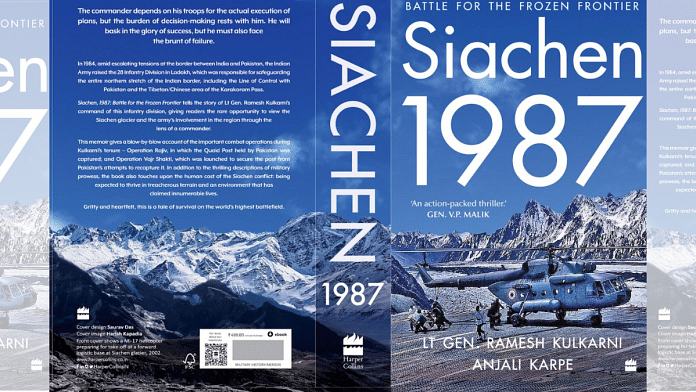New Delhi: Tensions between India and Pakistan were worsening in 1987 when then Maj. Gen. Ramesh Kulkarni was given the daunting task of commanding the 28 Infantry Division in Ladakh – which is responsible for safeguarding the entire northern stretch of the Indian border, including the Line of Control with Pakistan and the Karakoram Pass, which houses the Siachen Glacier.
In ‘Siachen 1987: Battle for the Frozen Frontier’, Lt. Gen Kulkarni (Retd) provides readers with an intimate view of the Siachen Glacier and the involvement of the defence forces through the direct and precise gaze of a commander.
Published by HarperCollins, the book will be released on 3rd November on Softcover, ThePrint’s online venue to launch non-fiction books.
The book is not a political analysis or a fictionalised memoir but is instead a story straight from the horse’s mouth. Kulkarni gives the much-needed context by taking the reader through the history and politics of Siachen.
The author recounts a plethora of important combat operations with startling clarity – “That whole stretch of time was so clearly etched in my memory that I could hear the voices of shared conversations while sipping chai at 20,000 feet. I could feel the biting chill of that wind that blew across the snows and the sweat that beaded my brow during intense decision-making.” Such is the immediacy with which the book is written.
He is also able to convey the immensity of what was being undertaken, the fact that it was a test of human capability, given the hostile terrain was an enemy in itself. While describing Operation Rajiv, in which the Quaid Post held by Pakistan was captured, Kulkarni writes: “Inducting troops in the manner that was planned – flying them from Kumar at 15,000 feet to 20,000 feet, the base of the Quaid post – would not be tolerated by the human body. Sure enough, for every two persons inducted, one person had to be brought back because he just could not withstand the sudden change in altitude.”
Another thrilling and terrifying sixty hours for Kulkarni and his division was Operation Vajrashakti in September 1987. At the time, firing from both sides was the norm since neither group could see the other and Pakistan regularly engaged in ‘speculative firing’. Nothing can be predicted in a war located in a region like this. This is what fuels Kulkarni’s narrative, as he delves into the many shocks and spur-of-the-moment decisions that framed his stint at Siachen.
He adds a personal touch and doesn’t get lost in explaining the jargon of military terms and the various details of operations. It is a story of people through and through. “It was past midday and for a while, we were all lost for words. The enormity of that transmission hit home and we knew it had changed the entire course of the battle and our planning. Just like that, those disembodied voices across the Saltoro, declaring that they could not go any further, made us realise that there would be no fresh action,” reads a passage from the book.
The book forbids the reader from forgetting there were real human beings behind the guns and under the uniforms. Every page serves as a reminder of a soldier’s sacrifice.
“Kulkarni’s reminisces of valour, heroism, and courage on the Siachen Glacier are like an action-packed thriller”, said General Ved Prakash, ex-chief of the Army Staff, about the book.
Also read: New book challenges ‘mainstream’ Indian history, brings to fore stories of 15 unsung heroes



